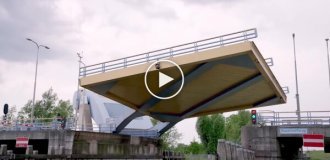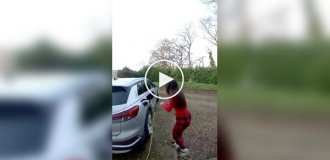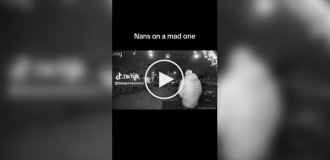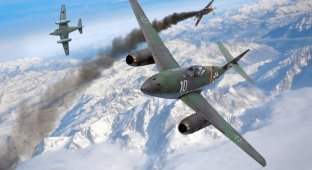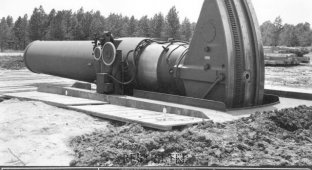Superguns: "Dora" and "Gustav" (8 photos)
"Dora" and "Gustav" - giant guns

The Dora super-heavy railway-mounted artillery gun was developed in the late 1930s by the German company Krupp. This weapon was intended to destroy fortifications on the borders of Germany with Belgium and France (Maginot Line). In 1942, "Dora" was used to storm Sevastopol, and in 1944 to suppress the uprising in Warsaw.
The development of German artillery after World War I was limited by the Treaty of Versailles. According to the provisions of this treaty, Germany was prohibited from having any anti-aircraft and anti-tank guns, as well as guns whose caliber exceeded 150 mm. Thus, the creation of large-caliber and powerful artillery was a matter of honor and prestige, the leaders of Nazi Germany believed.

Based on this, in 1936, when Hitler visited one of the Krupp factories, he categorically demanded that the company's management design a heavy-duty weapon that would be capable of destroying the French Maginot Line and the Belgian border forts, such as Eben-Emal. According to the requirements of the Wehrmacht, a cannon shell must be capable of penetrating 7 m thick concrete, 1 m thick armor, 30 m hard ground, and the maximum range of the gun should be 25-45 km. and have a vertical guidance angle of +65 degrees.
The group of designers of the Krupp concern, which began creating a new super-powerful gun according to the proposed tactical and technical requirements, was headed by Professor E. Muller, who had extensive experience in this matter. The development of the project was completed in 1937, and in the same year the Krupp concern was given an order for the production of a new 800mm caliber gun. Construction of the first gun was completed in 1941. The gun, in honor of E. Muller’s wife, was given the name “Dora”. The second gun, which was named “Fat Gustav” in honor of the management of the company Gustav von Bohlen and Halbach Krupp, was built in mid-1941. In addition, a third 520 mm caliber gun was designed. and a trunk length of 48 meters. It was called "Long Gustav". But this weapon was not completed.

In 1941, 120 km. west of Berlin, at the Rügenwalde-Hillersleben training ground, guns were tested. Adolf Hitler himself, his comrade-in-arms Albert Speer, as well as other high army officials were present at the tests. Hitler was pleased with the test results.
Although the guns did not have some mechanisms, they met the requirements that were specified in the technical specifications. All tests were completed by the end of the 42nd year. The gun was delivered to the troops. By this time, the company's factories had produced over 100 800 mm caliber shells.

The locking of the barrel bolt, as well as the delivery of projectiles, were carried out by hydraulic mechanisms. The gun was equipped with two lifts: for cartridges and for shells. The first part of the barrel was with a conical thread, the second with a cylindrical thread.
The gun was mounted on a 40-axle conveyor, which was located on a double railway track. The distance between the tracks was 6 meters. In addition, another railway track was laid on the sides of the gun for installation cranes. The total weight of the gun was 1350 tons. To fire, the gun needed an area up to 5 km long. The time spent preparing the gun for firing consisted of choosing a position (could reach 6 weeks) and assembling the gun itself (about 3 days).

Transportation of implements and maintenance personnel.
The gun was transported by rail. Thus, “Dora” was delivered to Sevastopol by 5 trains in 106 cars:
1st train: service (672nd artillery division, about 500 people), 43 cars;
2nd train, auxiliary equipment and erection crane, 16 cars;
3rd train: cannon parts and workshop, 17 cars;
4th train: loading mechanisms and barrel, 20 cars;
5th train: ammunition, 10 cars.
In World War II, Dora took part only twice.
The first time the gun was used was to capture Sevastopol in 1942. During this campaign, only one case was recorded of a successful hit by a Dora shell, which caused an explosion of an ammunition depot located at a depth of 27 meters. The remaining Dora shots penetrated the ground to a depth of 12 meters. After the explosion of the shell, a drop-shaped shape with a diameter of about 3 meters was formed in the ground, which did not cause much harm to the defenders of the city. In Sevastopol, the gun fired 48 shells.

After Sevastopol, "Dora" was sent to Leningrad, and from there to Essen for repairs. The second time Dora was used was in 1944 to suppress the Warsaw Uprising. In total, the gun fired more than 30 shells into Warsaw.

On April 22, 1945, the advanced units of the Allied army were 36 km away. from the city of Auerbach (Bavaria) they discovered the remains of the Dora and Gustav guns blown up by the Germans. Subsequently, everything that was left of these giants of the 2nd World War was sent for melting down.

